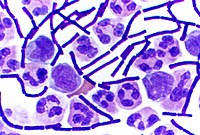Gram-positive bacteria

Gram-positive bacteria are like a club of cute tadpoles that have a purple shell around them. These tiny creatures are small living things that can be found everywhere, even on our skin and inside our bodies!
To understand what "gram-positive" means, you have to know about a special test used to identify different types of bacteria called "Gram staining."
Imagine a pack of fuzzy markers, some purple and others red. A scientist would use this pack of markers to color the tiny creatures so they can see them better with a microscope.
When we talk about "gram-positive" bacteria, it means that these tiny creatures are stained purple, while "gram-negative" bacteria are stained red.
Before getting too distracted by the colors, let's talk about the anatomy of gram-positive bacteria. These little guys have a thick cell wall made of a strong material called peptidoglycan. The thick cell wall acts as a protective shield around the bacterial cell and gives it a distinctive shape, like a cute tadpole!
The peptidoglycan layer also means that gram-positive bacteria tend to be more resistant to certain types of antibiotics.
Some examples of gram-positive bacteria are the ones that cause a sore throat (Streptococcus), pneumonia (Staphylococcus), food poisoning (Clostridium), and acne (Propionibacterium).
In conclusion, gram-positive bacteria are tiny creatures that have a purple shell around them, a thick peptidoglycan layer, and can be found all around us. They may cause diseases, but also have beneficial uses, such as helping with digestion in our gut!
To understand what "gram-positive" means, you have to know about a special test used to identify different types of bacteria called "Gram staining."
Imagine a pack of fuzzy markers, some purple and others red. A scientist would use this pack of markers to color the tiny creatures so they can see them better with a microscope.
When we talk about "gram-positive" bacteria, it means that these tiny creatures are stained purple, while "gram-negative" bacteria are stained red.
Before getting too distracted by the colors, let's talk about the anatomy of gram-positive bacteria. These little guys have a thick cell wall made of a strong material called peptidoglycan. The thick cell wall acts as a protective shield around the bacterial cell and gives it a distinctive shape, like a cute tadpole!
The peptidoglycan layer also means that gram-positive bacteria tend to be more resistant to certain types of antibiotics.
Some examples of gram-positive bacteria are the ones that cause a sore throat (Streptococcus), pneumonia (Staphylococcus), food poisoning (Clostridium), and acne (Propionibacterium).
In conclusion, gram-positive bacteria are tiny creatures that have a purple shell around them, a thick peptidoglycan layer, and can be found all around us. They may cause diseases, but also have beneficial uses, such as helping with digestion in our gut!
